
Although I wrote about this almost 6 months ago, I saw another link that I thought I should share. Best wishes to their continued success! (Pagh Salute: Sanaiya’s Dad!)
——————————————————————–
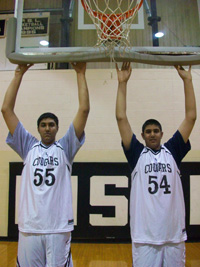 The lyrics once went something like:
The lyrics once went something like:
I wish I was little bit taller,
I wish I was a baller
I wish I had a girl who looked good
I would call her
I wish I had a rabbit in a hat with a bat
and a ’64 Impala
Don’t we wish we were the Bhullar Brothers. The phenoms are listed at 7’4 and 7’2. The sophomore Sim and freshman Tanveer (yes, really, sophomore and freshman) from Toronto are rejuvenating interest at the prep school – The Kiski School.
After a recent article in Slam Magazine’s online edition, the duo are generating tremendous publicity and scout and recruiters are paying attention:
Late last week I received an email from the Sikh Coalition titled “Victory in Texas!!! 4.8 Million Students to Learn About Sikhi”. The email stated the following:
(May 21, 2010) Today, the Texas Board of Education voted to include information on Sikhs and Sikh practices in the state mandated curriculum for public school students. This marks a significant victory for the Sikh community as Sikhs and Sikhi has never before been included in the state-wide curriculum.
In 2011, Texas students will learn about Sikhs at three points during their public school education. Sixth graders will learn about Vaisakhi when they learn about Christmas, Yom Kippur, Ramadan, and Diwali. High school students taking World History will learn about the origin of Sikhism and its basic beliefs. Finally, high school students will also learn locations of large Sikh populations in their World Geography classes.
The email continues in its excitement:
Texas Greatly Impacts the Rest of America
Texas is a very influential state for textbook manufacturers. State curriculum standards determine the content that will be included in new editions. Experts estimate that the decisions made by the Texas Board of Education affect the textbooks used in 46 other states because it is one of the largest purchasers of textbooks in the nation. In effect, Texas curriculum standards shape the content students will learn across the entire nation.
In all the exuberance, should we take a breath for the possible ramifications?
 I saw this on the New York Times right now and just thought I would share a nice story. If you get a chance, go watch the video. Congratulations Sona and Justin!
I saw this on the New York Times right now and just thought I would share a nice story. If you get a chance, go watch the video. Congratulations Sona and Justin!
About this time last year, in July, an attack on a dera in Austria sparked violence in Punjab. Six men have now been 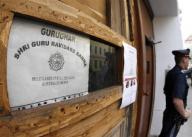 charged- one with murder, and five with attempted murder as accomplices – for the initial attack in Vienna.
charged- one with murder, and five with attempted murder as accomplices – for the initial attack in Vienna.
A 35-year-old man has been charged with murder and two counts of attempted murder, a Vienna court spokesman said. The five others are charged with being accomplices in attempted murder and with attempted severe assault on the worshippers. [link]
The five charged as accomplices are planning on pleading not guilty. [link]
The thirty-five year old charged with murder claims that he suffers from memory loss “after being subdued by worshippers wielding frying pans, a rolling pin and a microphone stand. The defence said it would submit a psychiatric assessment to the court.” He’ll be submitting a psychiatric evaluation to assess any such loss.
 I am assuming many in Canada probably don’t need an introduction, but as I just discovered the young boxer, I figure I could put the rest of the Langar Hall in the know.
I am assuming many in Canada probably don’t need an introduction, but as I just discovered the young boxer, I figure I could put the rest of the Langar Hall in the know.
This past weekend the young Sikh fighter lost to Jose Silveira of Mexico for the NABA bantamweight title. The loss was due to a judges’ decision after the referee called off the fight after Kooner suffered a cut to the nose from an accidental headbutt by Jose.
Possibly more interesting than this past weekend’s result is Andrew’s story.
In an interview with the Toronto Star, Kooner gave insights into how he got into boxing:
Born in Kettering, England, Kooner immigrated to Canada with his parents as a three-year-old. When he was 13, he joined the local Windsor Boxing Club, not because grew up a fight fan. He was one of the very few Sikh kids in his school and was being singled out on a regular basis.
“I was being tormented a lot,” he said, “and my parents felt boxing was a good way to channel my anger and frustration. Boxing ended up being a blessing.”[link]
The boxer has made previous Olympic appearances, the last time in 2004. Check out his website when you get a chance as well as pictures from his last fight. Talk about a Babbar entourage!
I guess I have a new favorite boxer. What ever happened to Pardeep?
The famed Grand Trunk Road, stretching from Bengal to Peshawar is made up of legends. Due to the “GT Road” passing through Punjab and the number of Punjabis involved in the transport business, references to the transport network can be found in music and popular iconography.
The road has a long history stretching from its early precursors during the brief rule of Afghan Sher Shah Suri, to greater development and expansion during the reign of the Mughals, finally to its naming as the Grand Trunk Road (GT Road) and paving under the colonial British Raj.
NPR is doing an extended story titled “Along the Grand Trunk Road: Coming of Age in India and Pakistan.” I’ll leave aside the colonial rhetoric of the title – coming of age? who decides? what does that really mean? Regardless there are a series of interesting vignettes as the NPR reporters travel the length of the modern road, through Amritsar and Darbar Sahib. Also enclosed on the story’s website are pictures documenting 150 years of history of GT Road. Do take a listen, or you can stick to Kuldip Manak if you prefer….

 Last month 17 Indian nationals were sentenced to die for killing a Pakistani man. 16 of the 17 men come from a Sikh background.
Last month 17 Indian nationals were sentenced to die for killing a Pakistani man. 16 of the 17 men come from a Sikh background.
The case has attracted some attention in the Indian press, but has now found place on the BBC and other sources due to Amnesty International, a premier human rights group, calling attention to the torture of the defendants.
Amnesty says the men were taken to the scene of the killing in the emirate of Sharjah and forced to re-enact it. It says they were made to beat a police officer posing as the dead man a month after their arrest – an act filmed and presented as genuine evidence.
Citing evidence produced by Indian rights group Lawyers For Human Rights International (LFHRI), Amnesty said that the 17 men were beaten with clubs, given electric shocks, deprived of sleep and forced to stand on one leg for prolonged periods.“This is a mockery of justice. These 17 men have been tortured, forced to confess and sentenced to death based on a faked video,” Amnesty’s deputy director for the Middle East and North Africa, Hassiba Hadj Sharaoui said.“Amnesty International is calling on the UAE authorities to investigate the allegations of torture and abuse and to ensure the 17 men receive a fair trial on appeal,” the group said in a statement. [link]
Guest blogged by Harkiran
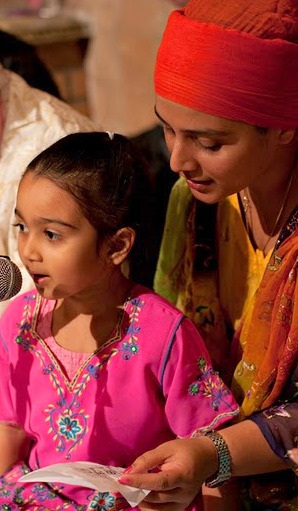
Becomes the first house of the man and yet it’s ironical, that its the woman that seeks a shelter all her life. As she grows up she leaves her house and her family to start a new life with her husband and then her own womb becomes the place where life comes to existence and get’s nurtured. Years of duality and other kind of “loves” doesn’t let man do justice even to the woman he calls mother.
There’s the Bani of Nanak that does justice to the status of a woman in society and then this Vaar by Bhai Gurdas Ji.
The Woman – Bhai Gurdas Ji
Vaar 5 Pauri 16
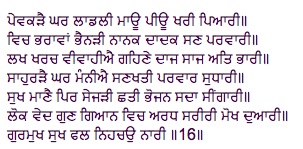
At birth a Sikh girl is ‘darling’ to her mother and father/ Later, she becomes admired by her brothers and sisters and favoured by her relatives / On attaining to ” the bloom of youth” she is wedded with costly gifts and presents / Now, respected by her husbands family and deemed lucky in her new household, she regarded as the equal of her spouse in both virtue and wisdom / She becomes as a doorway to salvation.
This beautiful verbal portrait written by Bhai Gurdas Ji not only makes you appreciate the beauty of a woman and but also puts ones mind in their creator too.
It can be said that extraordinary history is currently being made in the UK’s political environment. A possible Conservative-Liberal parliament is in the works – but the question remains – who will decide it? An interesting article in the Guardian discusses the need for a more diverse government to be formed.
The headline results are already solidly familiar. But it is the analysis of who voted where, and who they voted for, that will best illustrate the wider political health of the nation. Already, it is clear that once again the House of Commons is too white and too male and too middle class to reflect the people who voted for it. [link]
 There were a number of South Asian candidates who were hoping for seats in parliament. Gurcharan Singh was one such candidate (hat tip: Southall Lad). As the first turban wearing mayor of Ealing, Gurcharan stood as the Parliamentary Candidate for the Conservatives in Ealing Southall – a Labour stronghold for many years. The following is a message from the candidate,
There were a number of South Asian candidates who were hoping for seats in parliament. Gurcharan Singh was one such candidate (hat tip: Southall Lad). As the first turban wearing mayor of Ealing, Gurcharan stood as the Parliamentary Candidate for the Conservatives in Ealing Southall – a Labour stronghold for many years. The following is a message from the candidate,
If elected, I will make sure that I represent the concerns and interests of all communities. This will include visiting local Mosques, Mandirs, Churches and Gurdwaras. I would like to set up an inter-faith working group to ensure that we can tackle local issues together and in a unified manner. I believe that the issues we face cut across us all. For example, we all care about the NHS, we all care about the safety of our families, we all want to be able to express our religious freedoms without hindrance and we all care about education. Therefore, we should tackle these issues together. [link]
As the stupid joke once went – Sikhs’ only culture is agriculture.
While farming and agriculture has been the backbone of the political economy of Punjab, questions regarding current practices and sustainability have become more and more common. Impending water crisis, increasing cancer and mortality rates, and annual suicides related to crop successes and failures are all tied to the future of agriculture in Punjab.
Solutions come often. Crop diversification is one that is common. Here a CNN report calls for organic farming. Still one cannot help but wonder even with these ‘magic bullet’ solutions, can there be sustainable increases in the standard of living for all citizenry in an economy tied to industrial agriculture? Siphoning of Punjab’s wealth has for decades left state service (civil, military, police) as the most desired duty for all rural youth. In such a command economy, Punjab will always be at the whims of puppet masters in Delhi. Are there any alternatives?
Also here is a link to Umendra Dutt’s blog that does have some very interesting measures being taken by the Punjab organic movement, including many by women – the Kheti Virasat Mission.
Happy Mother’s Day to all the wonderful mother’s who have nourished our physical bodies with food made out of love and nurtured our souls with their warm spirits.
I leave you with one of Satinder Sartaaj’s most beautiful songs, “Ammi”. Among all the many Punjabi songs about mothers, Sartaaj has brought us one of the best. He captures a mother’s spirit and it’s priceless value to not only children but the world.

As we celebrate motherhood today, let’s also remember the value of the girl child. Guru Nanak Ji reminds us in Raaj Aasaa on Pannaa 473:
Few programs in the United States have become as popular as the Sidak Summer put on by Sikh Research Institute. If you have ever sought to explore Sikhi through an immersion in instruction, discussion, and study apply for the Sidak Summer Program now!
The program runs for 2 weeks, from August 1-15, 2010 in San Antonio, TX. 3 different tracks are available, custom for everybody’s previous knowledge levels: Introductory Sikhi 101, Advanced Sikhi 201, and Gurmukhi 101. Learn more about each program at the Sidak website. This summer see where Tvarikh (Revolution), Gurbani, and Rahit intersect to give us a Gurmat view. Apply now!

Vijay “Jay” Chand Gandhi was sworn in as California’s first South Asian federal judge on April 14th. He is only the second Indian American federal judge in the country. Gandhi will be a magistrate judge for the U.S. District Cou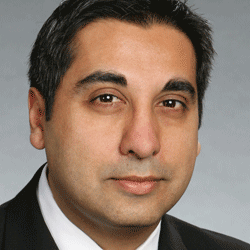 rt in California’s Central District. This district serves Los Angeles, Orange, Riverside, San Bernardino, San Luis Obispo, Santa Barbara and Ventura counties.
rt in California’s Central District. This district serves Los Angeles, Orange, Riverside, San Bernardino, San Luis Obispo, Santa Barbara and Ventura counties.
India-West reports, “The duties of magistrate judges include conducting preliminary proceedings in criminal cases, trying and disposing of misdemeanor cases, ruling on discovery disputes in civil cases, issuing reports in habeas corpus and civil rights cases, trying civil cases and other assigned matters.”
Kiran Jain, president of the South Asian Bar Association in Northern California, told India-West, “As the first South Asian federal judge in California, Judge Gandhi’s appointment is not only an historic advancement in increasing diversity in our judiciary, but a testament to the South Asian American legal community’s progress in advancing our bar to the highest levels of our profession.”
Congratulations Vijay Gandhi! It will be interesting to see if and how Gandhi utilizes his experience as a South Asian American in his work as judge. It is one thing to have a South Asian name and another to actually use your cultural experiences to help the community. I hope he views being a federal judge as an opportunity to shed light on the issues impacting the South Asian community while helping create larger policy changes.
As far as I know, there are no Sikh U.S. federal judges. Do you know of any? If not, I await the day we have Sikh U.S. federal judges. Hopefully it won’t be too much longer. Being a lawyer is one of the top 3 professions many Sikhs pursue any ways.
Guest blogged by Jind Kaur
For my inaugural [guest] post on The Langar Hall, I wanted to discuss something that is often on my mind when I think about our faith and how to practice it: the concept of sangat (the congregation). The Guru Sahibaan often impressed upon us how we should not isolate ourselves from the world in order to find salvation. We are taught that we must live amongst the world, and it is from the sangat where we learn and practice the teachings the Gurus pass on to us. “Satsangat Satgur Chattsaal Hai, Jit Har Gunh Sikha” “The Sat Sangat, the True Congregation of the True Guru, is the school of the soul, where the Glorious Virtues of the Lord are studied.” Participation and engagement with the sangat is considered essential for a Sikh’s spiritual progress. It is in the sangat that we worship and in the sangat where we are to receive training in our faith and its daily application. The sangat is our holy fellowship where we may become morally elevated.
But where is our sangat? Is our sangat in our Gurudwara, out in the world or some combination of both? Sometimes when I see the current state of our Gurudwaras, regardless of geography, it makes me want to stay home to pray quietly by myself and find other ways to do seva where it is needed. There is an epidemic of politics overtaking our Gurudwaras. However, this is enabled and encouraged by the absence of a true sangat.
When I was a teenager attending a particular Sikh camp, (I don’t want to date myself), I attended a lecture/discussion that has permanently imprinted itself in my mind. The man who led the discussion taught us about the root of the word “sangat” – this is “sang” (pronounced “sung”), which means “together”. Your sangat consists of those whom you walk with together in life. This led me to ask, not only where my sangat is, but who is in that sangat.
Guest blogged by Brooklynwala
While many of us were celebrating 311 years of the Khalsa at Sikh Day Parades and Nagar Kirtans this weekend, thousands of immigrants and their allies gathered in Phoenix, Arizona on Sunday to protest what is being called the 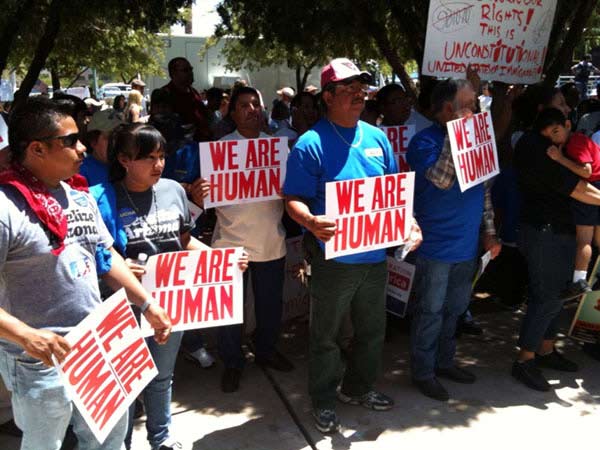 most anti-immigrant legislation in the United States, Senate Bill1070. Signed into law by Arizona Governor Jan Brewer on April 23rd, this measure allows local law enforcement authorities to question individuals based solely upon the suspicion that they may be undocumented.
most anti-immigrant legislation in the United States, Senate Bill1070. Signed into law by Arizona Governor Jan Brewer on April 23rd, this measure allows local law enforcement authorities to question individuals based solely upon the suspicion that they may be undocumented.
According to the New York Times, “The law…would make the failure to carry immigration documents a crime and give the police broad power to detain anyone suspected of being in the country illegally. Opponents have called it an open invitation for harassment and discrimination against Hispanics regardless of their citizenship status.”
President Obama stated that the law threatens “to undermine basic notions of fairness that we cherish as Americans, as well as the trust between police and our communities that is so crucial to keeping us safe.”
Gurinder Chadha of Bend It Like Beckham fame returns with a new film, titled “It’s A Wonderful Afterlife.” The movie centers on the trials and tribulations of Rupy, a slightly overweight 20-something year old and her zealous Punjabi mother, who will stop at nothing to see her daughter happily married – including killing a few people along the way.
The film is being billed as a ‘zom-rom-com’ and is receiving rather mixed reviews in the UK. The film gives Punjabi billing on its soundtrack to well-known producers and artists, such as Panjabi MC, Kidd Skilly, and even Taz of Stereo Nation. See the trailer here and look for an interview with the film-director with Al-Jazeera’s Robert Frost after the jump. If you’ve seen the movie or are waiting for it, tell us your thoughts!

I have noticed these past couple of weeks that discussions about the value of Punjabi have become more prevalent. The issue of maintaining our “ma boli” is constantly on our minds and manifests in our everyday lives. However, with the onset of many Vaisakhi melas, Nagar Kirtans, and of course Satinder Sartaj concerts the discussions are heightened.
Recently, on Jus Punjabi’s “Aaj Da Mudda” show, there was an insightful conversation about pronunciation and the longevity of Punjabi. The host and guest discussed how East Punjabi’s pronunciation of words have changed (we are taking the easier route). Despite this change in pronunciation, the guest highlighted how Punjabi has survived the most turbulent of times (e.g. the state language during Maharaja Ranjit Singh’s rule was Farsi and the 1960’s division of India Punjab).
As he spoke, I was reminded of Gurdas Mann’s song “Punjabiye Zubane” (listen below). This song captures how the strength of the Punjabi language was developed over time. It is this strength that has allowed it to survive. I am left wondering if we 1) have the will and 2) the capacity to nurture and love this language like others have done in the past. Can we help nurture the strength of Punjabi in today’s context? What do you think?

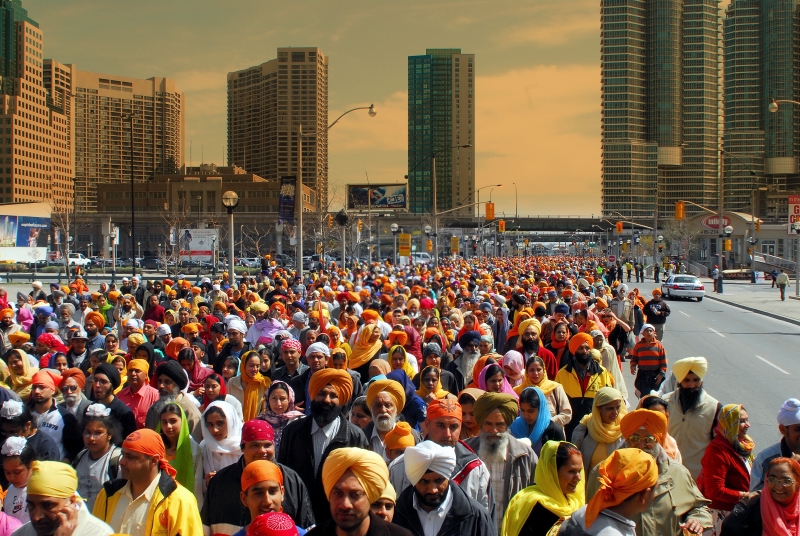 A few weeks back, we attended our first Sikh Parade of the season.
A few weeks back, we attended our first Sikh Parade of the season.
Like every year, we love making the trip downtown to join our sangat and spend a beautiful spring day outside celebrating Vaisakhi. Amongst the sea of kesri dastaars and chunnis, there was keertan, gatka, and jakaaray filling the streets.
As we began marching down the main avenue, I started to notice the passerby’s reaction to us. Some were irritated they had to wait for us to cross the street, some took out their camera phones to take pictures of us, but the vast majority looked, well…confused.
And who can blame them?
None of our floats and few of our signs would make any sense to a non-Sikh. The overlapping keertan, jakaaray, and political slogans were obviously all in Punjabi. And there was little to no interaction between us and the onlookers. I wondered, why did we come here to do this?
If our purpose was to have a nagar keertan and to celebrate Vaisakhi in our own traditional way, then why waste the time and money to do it out here? Why not just do this on our own Gurdwara premises? But if our purpose was to educate the greater community on who Sikhs are, then what exactly were we doing to accomplish that? Sure, many people were taking pictures of us, but was it because of the spectacle we created? Or because people were so happy to see the Sikhs that they’ve heard so much about – followers of Guru Nanak, brave soldiers, and defenders of the downtrodden? Which do you think?
Continue Reading »
As many of us reflect upon the birth of the Khalsa this Vaisakhi, throughout North America (and beyond) our communities come together in celebration. Covered here is a round-up of Vaisakhi celebrations with various media links. If your city is covered here, provide us some context/anecdotes about your experience. If your city is NOT covered here, provide us some context/anecdotes about your experience.
 The Sikh Youth Scholarship is a scholarship program created by youth and provided to youth. The Scholarship is open to aspiring Gursikh students residing in New Jersey, New York, Connecticut or Pennsylvania. Students must be high school seniors who plan to attend a four-year college/university and have maintained at least a 3.0 GPA during high school in order to be eligible to apply. In 2009, the program provided $7,500 in scholarship funding to three students. The unique aspect of the program is that the scholarship recipients are now part of the scholarship planning team and can truly give back to the community.
The Sikh Youth Scholarship is a scholarship program created by youth and provided to youth. The Scholarship is open to aspiring Gursikh students residing in New Jersey, New York, Connecticut or Pennsylvania. Students must be high school seniors who plan to attend a four-year college/university and have maintained at least a 3.0 GPA during high school in order to be eligible to apply. In 2009, the program provided $7,500 in scholarship funding to three students. The unique aspect of the program is that the scholarship recipients are now part of the scholarship planning team and can truly give back to the community.
In the first year of the Sikh Youth Scholarship, three scholarships were awarded to Rashmeen Kaur, Amrit Kaur Bhinder, and Tarika Kaur Virdi for the 2009-2010 academic year. The winners are now a part of the Sikh Youth Scholarship Executive Board and have been assisting in the expansion of the scholarship as a means of assisting their fellow students within the Sikh community. The Sikh Youth Scholarship is a completely community funded endeavor, made possible by sevadaars like you. Through your generous donations, we were able to award three scholarships of $2,500 each to these aspiring Gursikhs, in addition to funding their costs for Camp Chardi Kala in the summer of 2009. [From Press Release]
The scholarship program has an informative site where interested students can learn more and apply!
